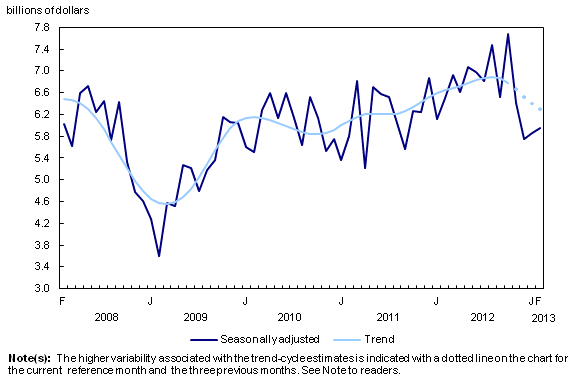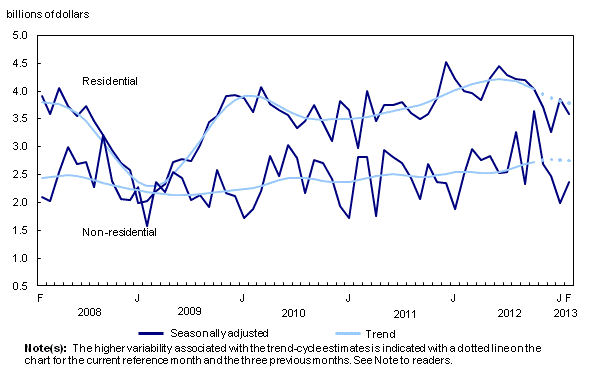Building permits, February 2013
Archived Content
Information identified as archived is provided for reference, research or recordkeeping purposes. It is not subject to the Government of Canada Web Standards and has not been altered or updated since it was archived. Please "contact us" to request a format other than those available.
Released: 2013-04-09
Canadian municipalities issued building permits worth $6.0 billion in February, a 1.7% increase from January. Higher construction intentions in the non-residential sector in eight provinces, led by Alberta, more than offset a decline in the residential sector. Despite February's advance, the total value of building permits has been trending downwards since late 2012.
With gains in all three components, the value of permits in the non-residential sector increased 18.9% to $2.4 billion, following three months of declines. Non-residential construction intentions rose in every province except New Brunswick and Nova Scotia. However, after an upward trend in mid-2012, the total value of non-residential building permits has been relatively flat since fall 2012.
Construction intentions in the residential sector fell 7.2% to $3.6 billion in February, the ninth decrease in 12 months. Residential construction intentions have been pursuing a downward trend that began in mid-2012. An increase in construction intentions for single-family dwellings was not enough to offset widespread declines in construction intentions for multi-family dwellings. The value of permits for residential buildings declined in seven provinces, led by British Columbia and New Brunswick.
Non-residential sector: Higher construction intentions in all components
Construction intentions in the commercial component increased 13.2% to $1.5 billion, continuing an upward trend that began in late 2011. Gains in four provinces, led by Alberta and British Columbia, more than offset losses in the remaining provinces. The advance was largely attributable to higher construction intentions for recreational facilities and office buildings in Alberta, while in British Columbia, the gain came from retail outlets, hotels and restaurants, and warehouses.
The value of institutional building permits increased 27.8% to $447 million, following a 29.9% decrease in January. Construction intentions for institutional buildings have been trending slightly downwards since the middle of 2012. The increase in February came from a variety of buildings including educational institutions, medical facilities and government buildings. Advances were posted in the Northwest Territories and in six provinces, led by Ontario, followed by Quebec and Alberta.
In the industrial component, the value of permits grew 34.7% to $400 million in February. This was the first increase in four months and was largely on the strength of industrial construction intentions in five provinces, led by Alberta, Ontario and Newfoundland and Labrador. Transportation-related buildings and manufacturing plants were behind the increase in Alberta. The gain in Ontario originated from transportation-related buildings as well as mining and primary industry buildings. In Newfoundland and Labrador, the gain came principally from utilities buildings.
Residential sector: Lower intentions for multi-family dwellings
Construction intentions for multi-family dwellings decreased 19.1% to $1.3 billion, the seventh decrease in eight months. The decrease came from every province except Prince Edward Island. Most of the decline was accounted for by New Brunswick, British Columbia and Ontario.
In February, municipalities issued $2.3 billion worth of building permits for single-family dwellings, up 1.1% from January and the second consecutive monthly increase. Higher construction intentions in Alberta, Manitoba and Ontario more than offset decreases in five provinces led by Saskatchewan, British Columbia, and Newfoundland and Labrador.
Municipalities approved the construction of 14,071 new dwellings in February, down 12.0% from January. February's decrease was largely the result of a 21.0% decline in multi-family dwellings to 7,537 units. The number of permits issued for single-family dwellings rose 1.2% to 6,534 units.
Provinces: Alberta posts a large increase
In February, the value of building permits advanced in four provinces. Alberta posted the largest advance, followed by Quebec, Manitoba and Ontario.
In Alberta, construction intentions grew 17.7% following two consecutive monthly declines. The increase was a result of higher construction intentions for non-residential buildings, particularly commercial buildings, and single-family dwellings. In Quebec, construction intentions advanced 4.1% on the strength of higher construction intentions for institutional buildings, single-family dwellings and commercial buildings.
The increase in Ontario resulted from higher intentions for institutional and industrial buildings. In Manitoba, the advance came from single-family dwellings, commercial buildings and, to a lesser degree, industrial buildings.
The largest decrease occurred in New Brunswick, one month after the total value of permits in the province more than tripled. The decline was a result of lower construction intentions in every component led by multi-family dwellings and institutional buildings. In British Columbia, the value of permits for multi-family dwellings and institutional buildings was behind the decline.
Permit values rose in more than half of the census metropolitan areas
The value of permits increased in 19 of the 34 census metropolitan areas (CMAs) in February.
Calgary, Edmonton and Kingston recorded the largest increases. The advance in Calgary was mostly attributable to commercial buildings and, to a lesser extent, multi-family dwellings and industrial buildings. Edmonton's gain stemmed from commercial and institutional buildings, as well as single-family dwellings. In Kingston, the increase came particularly from higher construction intentions for residential, commercial and institutional buildings.
The largest decreases occurred in Toronto, Moncton and Vancouver. In Toronto, the decline originated from residential dwellings and commercial buildings. Lower intentions for multi-family dwellings were behind the decrease in Moncton. The decline in Vancouver came mainly from lower intentions for multi-family dwellings and institutional buildings. All three CMAs had posted strong increases in the previous month.
Note to readers
Unless otherwise stated, this release presents seasonally adjusted data, which facilitates comparisons by removing the effects of seasonal variations. For more information on seasonal adjustment, see Seasonal adjustment and identifying economic trends.
The Building Permits Survey covers 2,400 municipalities representing 95% of the population. It provides an early indication of building activity.
The communities representing the other 5% of the population are very small, and their levels of building activity have little impact on the total for the entire population.
The value of planned construction activities shown in this release excludes engineering projects (for example, waterworks, sewers or culverts) and land.
For the purpose of this release, the census metropolitan area of Ottawa–Gatineau (Ontario/Quebec) is divided into two areas: Gatineau part and Ottawa part.
Revision
Data for the current reference month are subject to revision based on late responses. Data have been revised for the previous month.
The trend-cycle estimates have been added on the charts as a complement to the seasonally adjusted series. Both the seasonally adjusted and the trend-cycle estimates are subject to revision as additional observations become available. These revisions could be large and even lead to a reversal of movement, especially at the end of the series. The higher variability associated with the trend-cycle estimates is indicated with a dotted line on the chart.
The February 2013 issue of Building Permits (Catalogue number64-001-X) will soon be available.
Building permits data for March will be released on May 6.
Contact information
For more information, contact us (toll-free 1-800-263-1136; infostats@statcan.gc.ca).
To enquire about the concepts, methods or data quality of this release, contact Mariane Nozière Bien-Aimé (613-951-7520), Investment, Science and Technology Division.
- Date modified:



